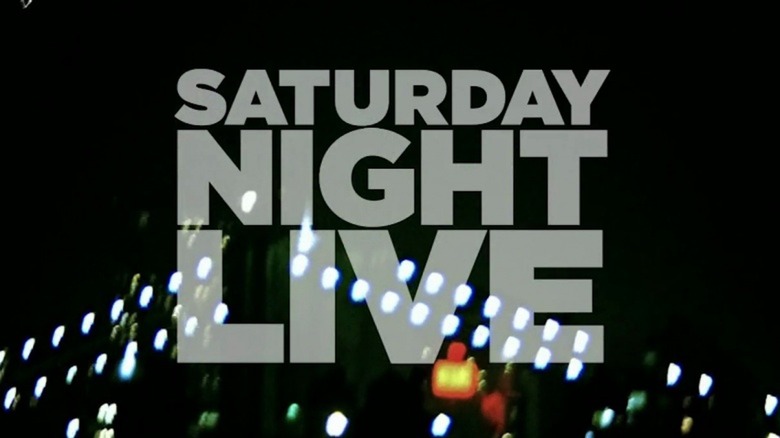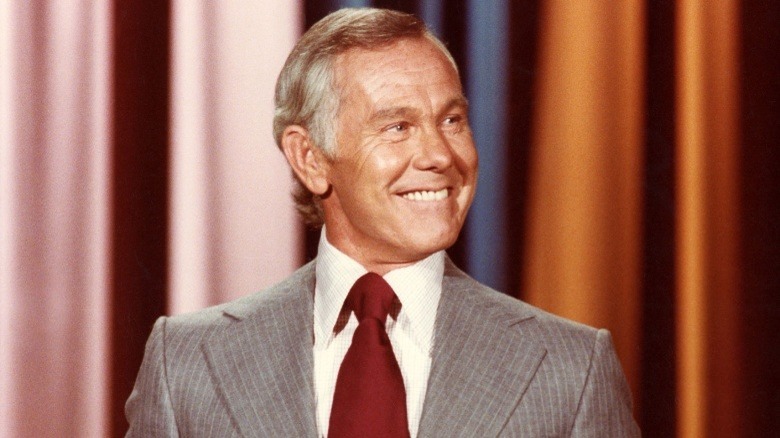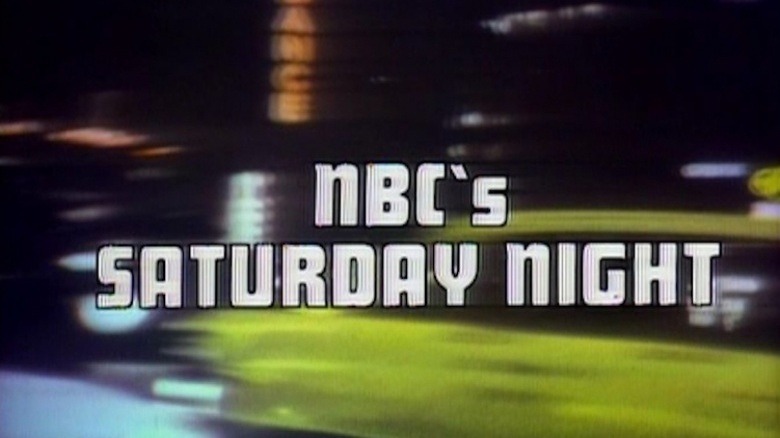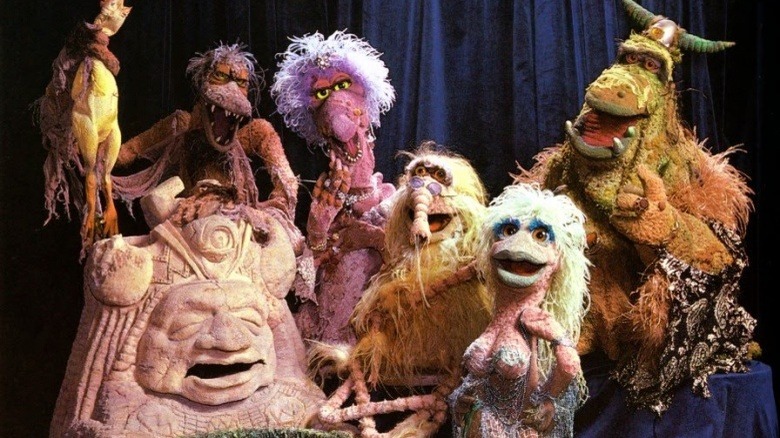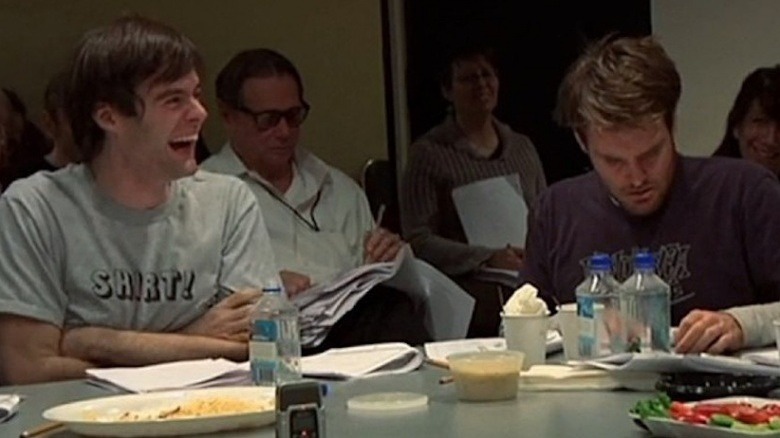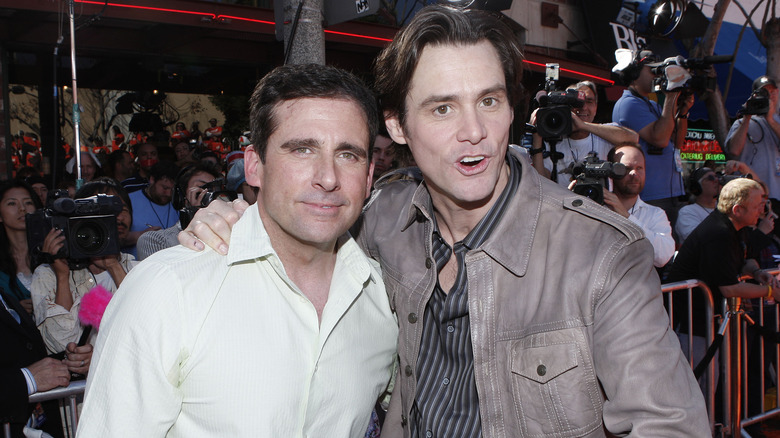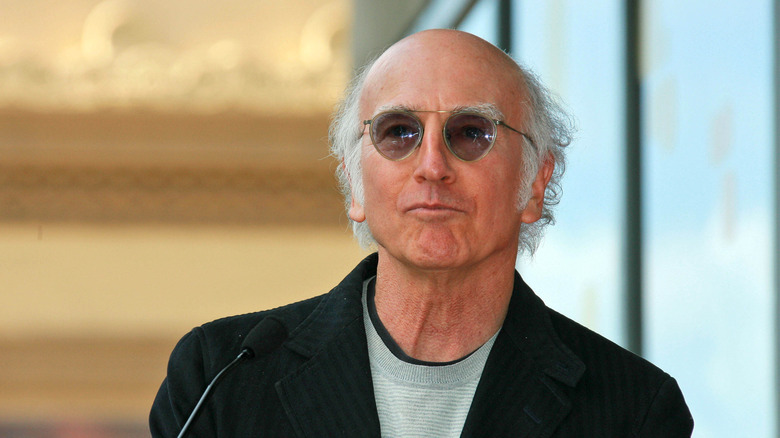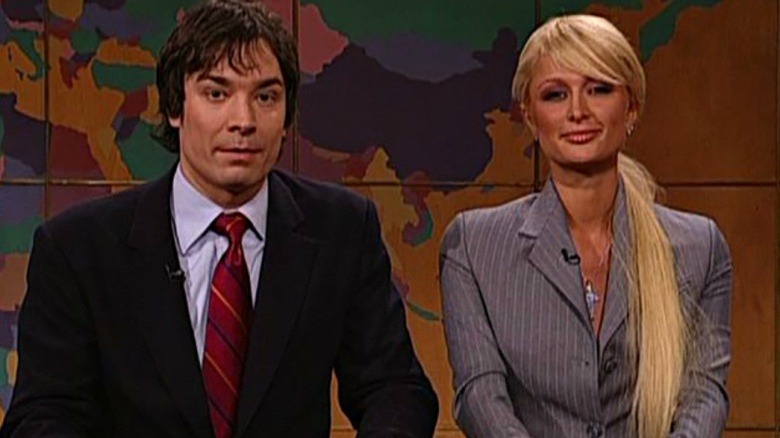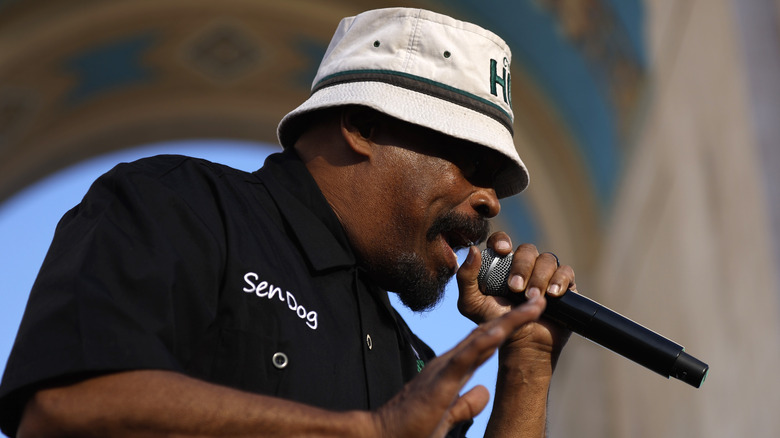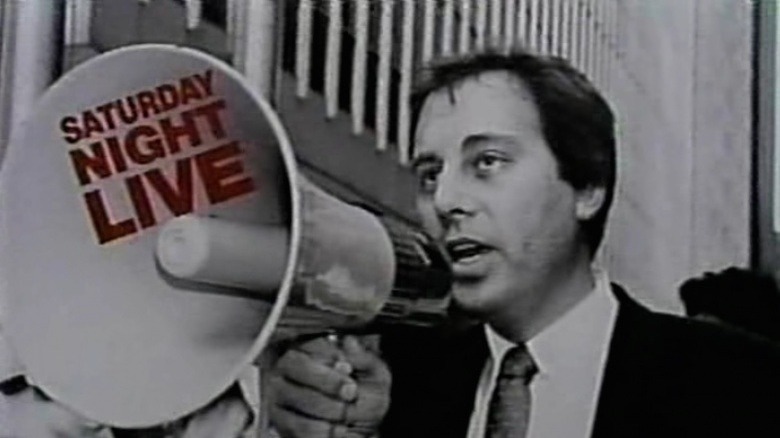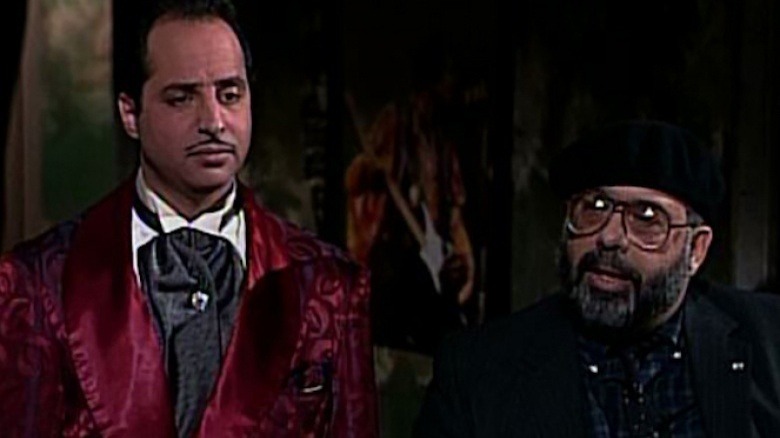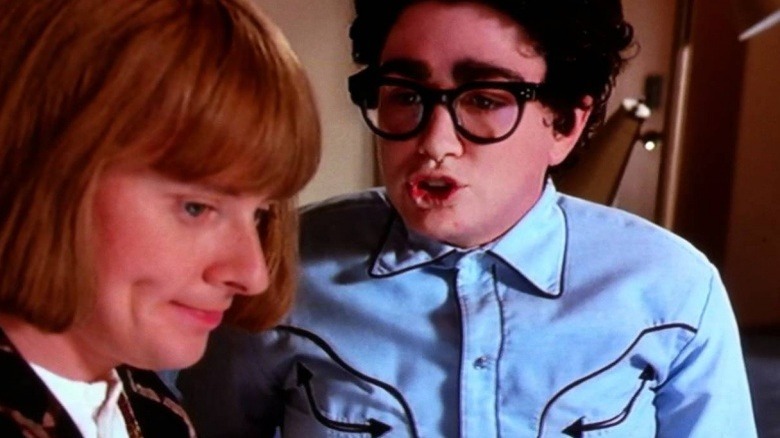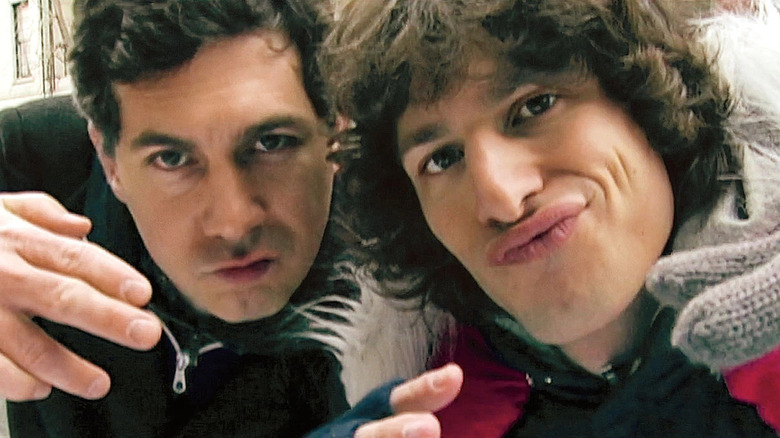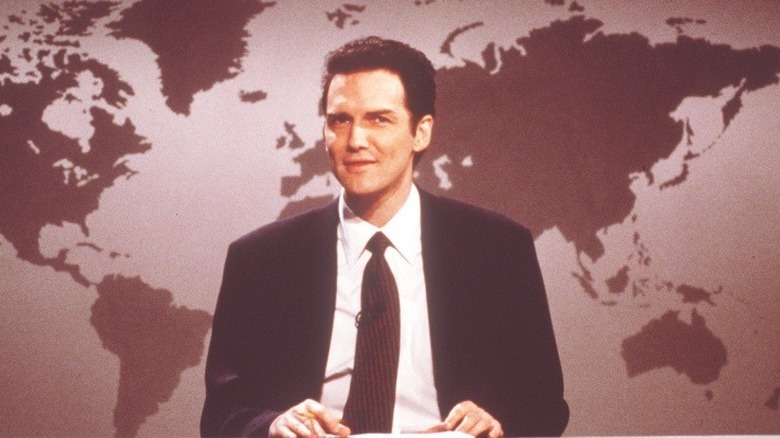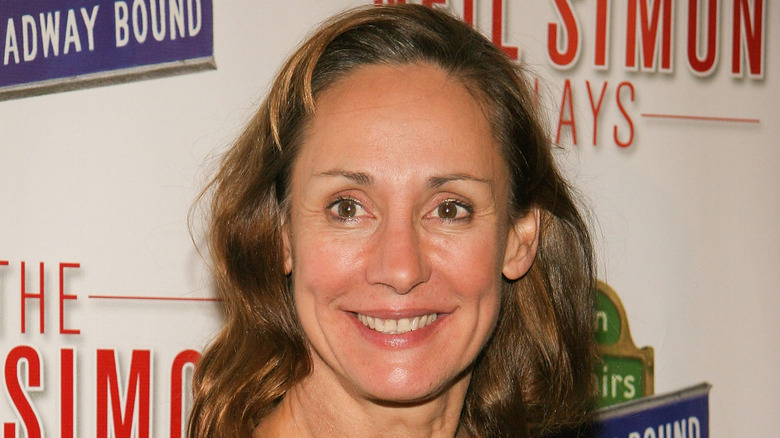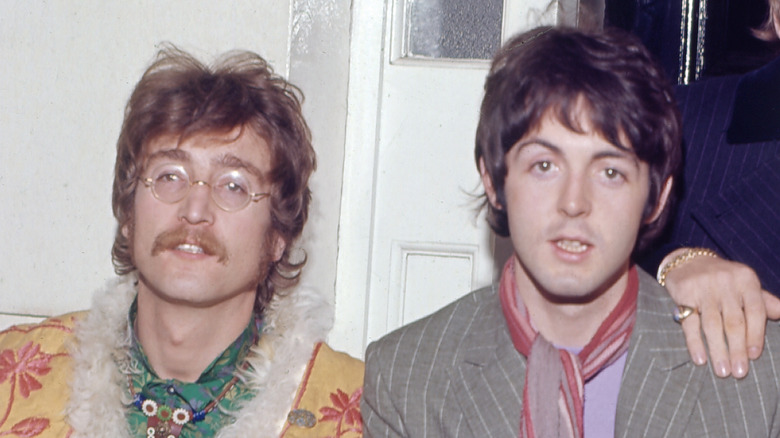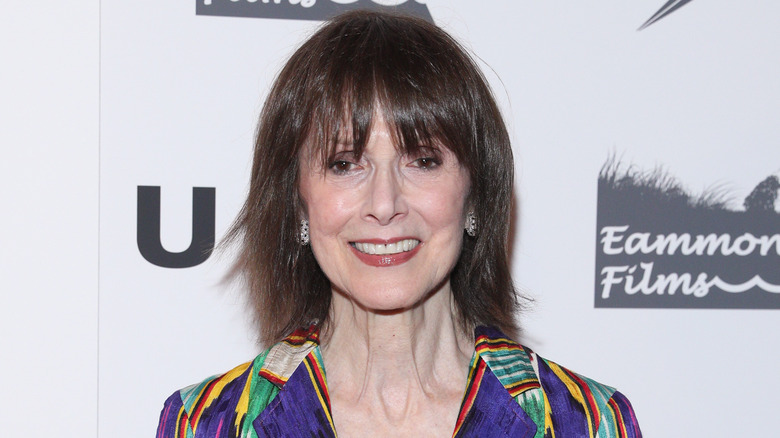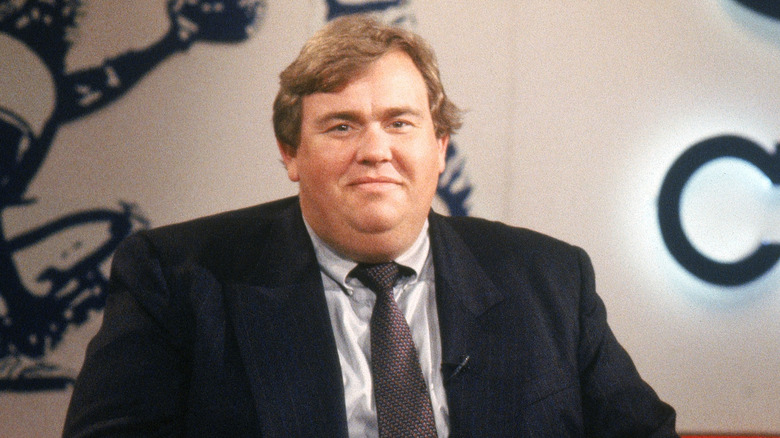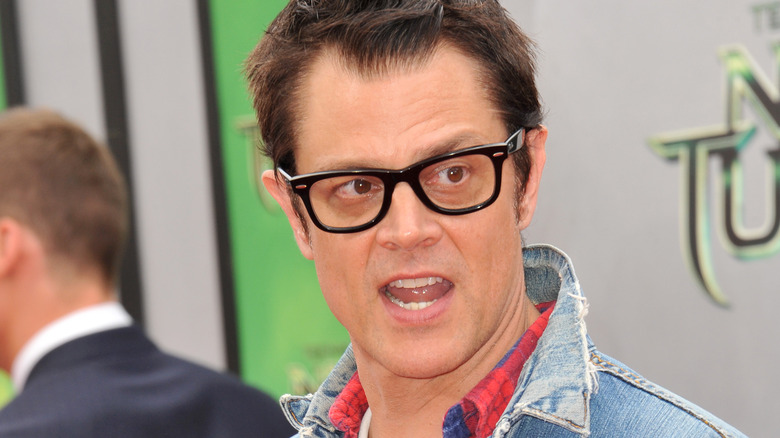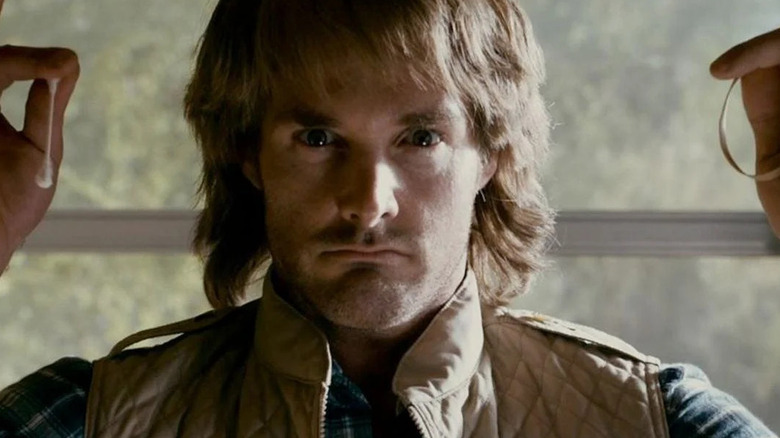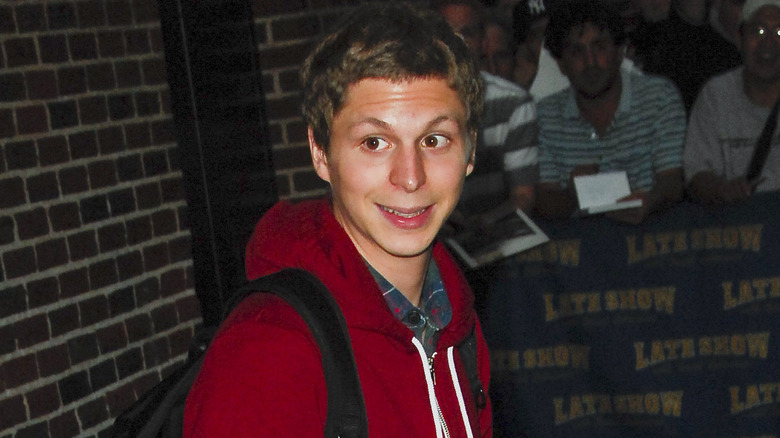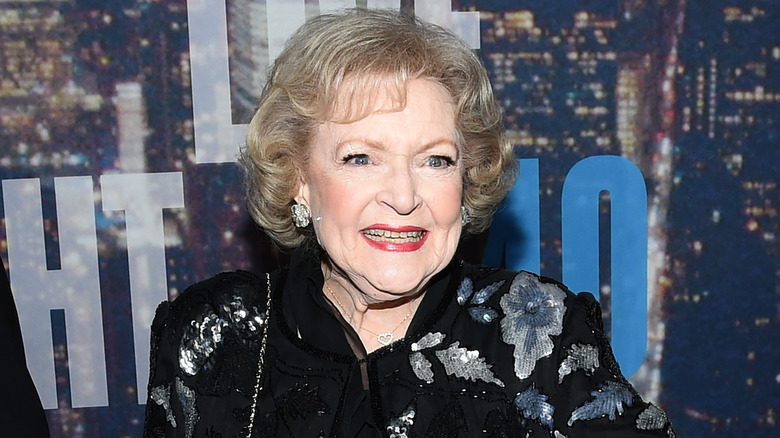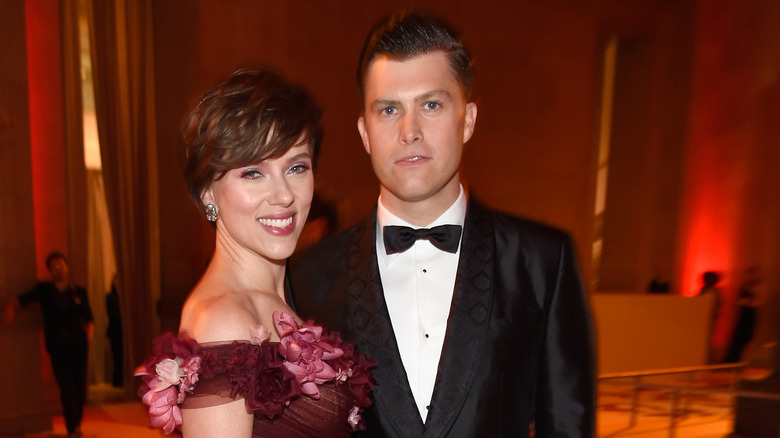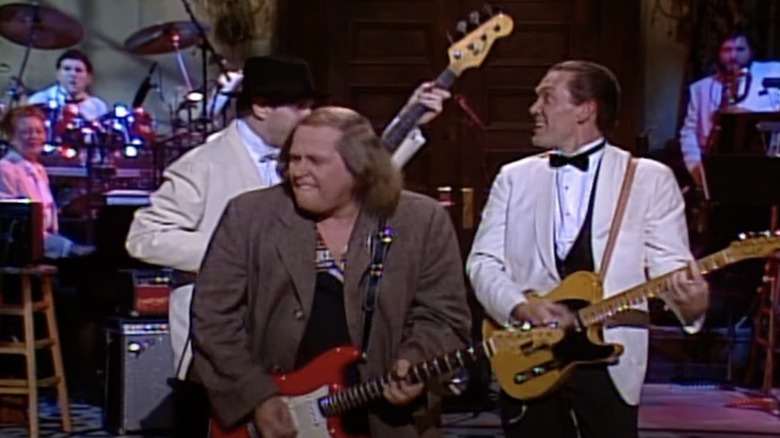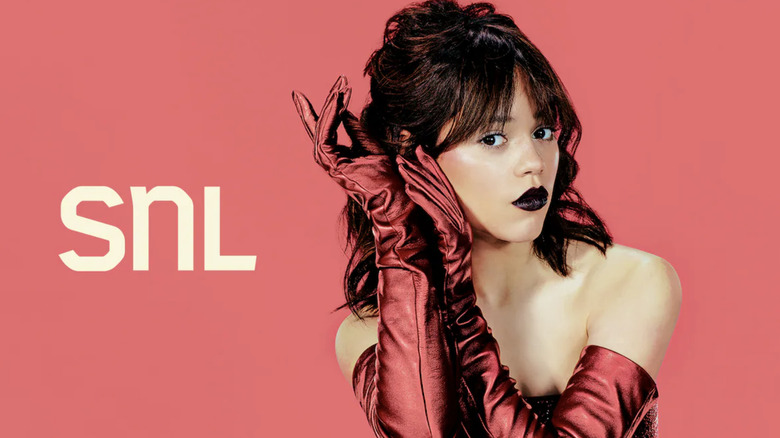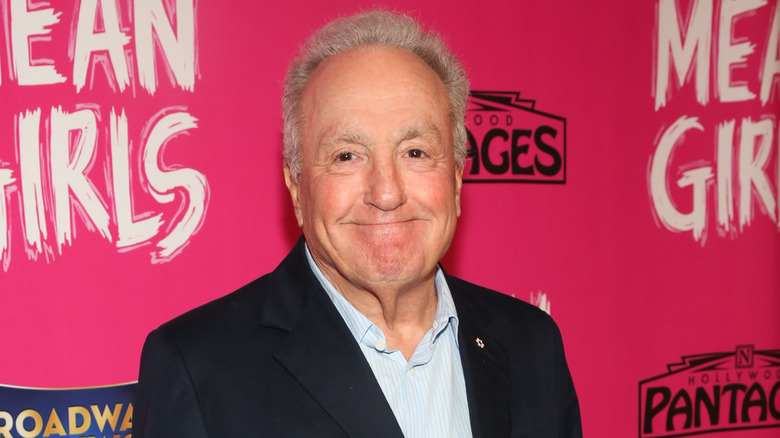The Untold Truth Of Saturday Night Live
Over the course of more than 40 years and nearly 1,000 episodes, "Saturday Night Live" has been among the most prestigious and influential comedy shows in the history of American TV. An exciting throwback to the way television used to be made, "SNL" still hits the airwaves each week in the way that it did back in 1975 — live at 11:30 p.m., from NBC's facility at 30 Rockefeller Center.
"SNL" has significantly shaped entertainment, discourse, and pop culture in its time as the pre-eminent sketch comedy show. Its political sketches skewer leaders, the "Weekend Update" pretend-news skewers cultural events, the musical guest slot exposes up-and-comers to new fans, and the comedy bits generate catchphrases and iconic characters. Dozens of movie and TV stars first came to fame on "SNL," like Adam Sandler, Will Ferrell, Chris Rock, Dana Carvey, Kristen Wiig, Bill Hader, Eddie Murphy, Dan Aykroyd, Bill Murray, and Julia Louis-Dreyfus. Even veteran writer and performer Al Franken became a U.S. Senator. The show is just as vital and popular in the 21st century as it was throughout the late 20th. It's got a big history, and here then are some stories you may not know about "SNL."
Johnny Carson forced NBC to create it
In 1974, Johnny Carson was the biggest moneymaker on television. He brought NBC about $60 million a year, according to The New Yorker, which earned him quite a bit of leverage when negotiating an extension on his contract to continue making "The Tonight Show." The program aired weeknights at 11:30 p.m., and back then, NBC filled the time slot on Saturdays with a "Tonight Show" clip show called "The Best of Carson." But when he told NBC he'd only make four new shows each week, moving "The Best of Carson" to a weeknight, Carson left NBC with a 90-minute hole in the Saturday night schedule.
The network decided to try out a late-night variety show geared to a young, hip audience. To run it, executives tapped 30-year-old Canadian comedy writer, Lorne Michaels, best known for his work on an Emmy-winning Lily Tomlin special. It took Michaels a year to work out the format and find a cast of seven sketch comedians, but in October 1975, the show was ready to go.
It had a different name
During its first season on TV — 1975–76 — the show wasn't actually called "Saturday Night Live," as that title was already in use. Sportscaster Howard Cosell (of all people) hosted an ABC primetime variety show with the name and, oddly enough, future "SNL" star Bill Murray was one of the stock players. But when that show was canceled, NBC snapped up the title, replacing the bland original, "NBC's Saturday Night." That's why at the beginning of each show, a performer says, "Live from New York, it's Saturday Night!"
And while the show's opening sequence now features the main cast and featured players' names read loudly and excitedly by Darrell Hammond (who replaced longtime announcer Don Pardo after his death in 2014), the "SNL" cast members weren't introduced individually during the first season. The obscure comedians were instead dubbed the "Not Ready for Primetime Players." But Dan Aykroyd, Chevy Chase, Jane Curtin, Gilda Radner, and the others, wouldn't stay anonymous for long.
It used to have Muppets
Nowadays, the show is pretty much all comedy with a couple of musical performances thrown in. But in the early years, "Saturday Night Live" was a true variety show. The Muppets were frequent guests on the late-night circuit in the mid-'70s, so it only made sense to include them. But we're not talking about Kermit, Fozzie, and Miss Piggy here. Instead, Jim Henson and his cohorts created a whole slew of new, monstrous, adult-oriented creatures for a segment called "The Land of Gorch."
It might have been the first and only time a Muppets project was not well-received. Considered not as fresh and urgent as the "SNL" manic sketch comedy, the segment ground each show to a halt. And due to Writers Guild rules, the sketches couldn't be written by Muppets writers — leaving regular "SNL" writers to do it, and they resented the puppets for taking up valuable airtime. The Muppets were gone after the first season.
The production schedule has remained the same
Per Business Insider, here's the timetable for how an episode of "SNL" is produced:
Monday: The guest host arrives at 30 Rockefeller Center in New York City, where "SNL" is shot. They go to Michaels' office, where they talk to writers and cast members about their comedic strengths, impressions they can do, and other suggestions. Writers then pitch their ideas.
Tuesday: As a holdover from the show's cocaine-fueled days in the '70s, writers spend all day and night writing their sketches. The host and a cast member also shoot short commercials to promote the episode. They're edited and put on the air within hours of being shot.
Wednesday: The table read is at 4 p.m. Every proposed sketch is included, so it usually takes at least three hours. Then producers and the head writers determine which sketches are good enough.
Thursday: At 6 a.m., builders begin constructing sets at a shop in the Brooklyn Navy Yard. At 30 Rock, the crew firms up plans for costumes, wigs, and makeup. Any pre-taped video bits are recorded.
Friday: Rehearsals and rewrites.
Saturday: The sketch order is set and presented to a live audience at 8 p.m. Any last-minute changes (or sketches that are cut) happen by 11:30 p.m. when the show goes live.
The audition process
After one "SNL" season ends and another begins, at least a couple of veteran cast members decide to leave the series. That presents an opportunity for "SNL" brass to bring in new performers, which helps keep the show fresh in terms of comedic voices and styles. "Saturday Night Live" talent scouts and producers find those next-generation and emerging stars who might be a good fit for the show by casting a wide net.
While they'll consider online comedians and take recommendations ("SNL" host Megan Mullally alerted the show to Bill Hader, for example), comedy hotbeds like the Groundlings in Los Angeles or the Upright Citizens Brigade in New York often arrange showcases for top talent, and Michaels and other show staffers, writers, and cast members attend. If they like what they see, they invite the performers to an audition on the "SNL" stage. Hopefuls have 10 minutes to do stand-up or present at least two original characters and celebrity impressions.
Some big names didn't make the cut
Getting on "Saturday Night Live" has been a career goal for thousands of comedians and actors, but only a few make the cast each year. That makes for a long list of performers who auditioned, didn't make it, then went on to achieve fame and fortune anyway.
Among them are Jim Carrey (who lost a spot in 1980 to Charles Rocket), 13-time host John Goodman (inched out by Joe Piscopo), Kevin Hart, Geena Davis, Paul Reubens (a.k.a. Pee-wee Herman), Stephen Colbert, Steve Carell (he and his wife, Nancy Walls, tried out in 1995 — she got on, but Carell lost the spot to Will Ferrell), Aubrey Plaza (who was an intern for the show), Louis C.K., Marc Maron, Lisa Kudrow, Donald Glover, Kel Mitchell of "Kenan and Kel" (he lost out to his co-star, Kenan Thompson), and Zach Galifianakis (who was hired as a guest writer).
It's tough to get screen time on SNL
With more than a dozen performers and at least that many writers in direct competition with each other to fill just about an hour of sketch time, somebody is going to get left out. In his book, "Gasping for Airtime," former cast member Jay Mohr said he was so desperate to get a sketch on the air in 1995, that he stole a routine by comedian Rick Shapiro and turned it into "O'Callahan & Son Pub." Two months later, "SNL" fired Mohr.
And while Larry David eventually went on to co-create "Seinfeld" and star in "Curb Your Enthusiasm," he had an uneventful spell as an "SNL" writer in 1984. Back then, only one of his sketches made it to air: an odd piece called "Elevator Stool." In it, an architect (host Ed Begley Jr.) becomes frustrated that a client (Harry Shearer) wants to make sure that the elevators in the new building have stools for elevator operators. David later recycled the bit for an episode of "Seinfeld."
Some hosts are better than others
It's obvious which guest hosts "SNL" likes the most, because they're the ones who keep coming back. Steve Martin, Alec Baldwin, Woody Harrelson, and Melissa McCarthy are a few who have meshed well with the program. On the other end of the spectrum, there are hosts who will likely never return because they were difficult to work with, obnoxious, or both.
In a 1992 episode, host Nicolas Cage confides to Michaels that he fears he'll be the worst host in the show's history. "No," Michaels replies. "That would be Steven Seagal." Al Franken wrote that not-really-a-joke, but many SNL alumni, including David Spade, have named the martial arts actor the show's worst host.
But according to Michaels, the worst was probably early TV star Milton Berle, who guested in 1979 and disrupted the show with mugging, ad-libbing of old and tired jokes, and arranged beforehand to have the studio audience give him a standing ovation at the end. Tina Fey, however, didn't beat around the bush when she told Howard Stern who she thought was the worst: Paris Hilton.
Some people aren't welcome back
While many of the show's performers come from an improv comedy background, it's forbidden to improvise on SNL. The show has to be planned down to the second to account for each sketch, musical performance, and a commercial break. But not every host and musical guest follows that rule, and many were subsequently banned.
In 2003, Adrien Brody did an impromptu, borderline racist bit with a Jamaican accent while introducing reggae singer Sean Paul. In 1996, Rage Against the Machine asked for two upside-down American flags to be hung on the stage. When producers said no, the band hung them up anyway. Stagehands tore them down just seconds before they were supposed to perform, and their second song was canceled. The musicians were escorted from the building before the episode had even finished. Sen Dog of Cypress Hill claimed his group earned a ban after smoking marijuana during their "SNL" performance. And let's not forget Sinead O'Connor's infamous pope incident in 1992.
Some sketches don't make the reruns
Just because an "SNL" episode airs, it doesn't mean it stays that way forever. Producers often tinker with shows for reruns, often replacing a sketch that went poorly with a superior version recorded during dress rehearsal. That means some "lost" sketches only survive on DVD and streaming versions. One of them, "Butt County Dance Party," aired in 1976. In the sketch, a small-town sheriff (Dan Akroyd) hosts a TV dance show, and "winners" get to have their names run through a teletype machine to check for outstanding warrants. But when the machine malfunctioned, Akroyd tried to improvise and told everyone to keep dancing, although there was no music.
NBC cut to random stock footage of car crashes, then pulled the sketch from reruns. In another instance from 1985, NBC president Brandon Tartikoff appeared in a sketch to collect urine samples from cast members for drug testing, but it was later deemed to be in poor taste. In the reruns, it's swapped out for an extra musical performance by Simple Minds.
When things got weird with Francis Ford Coppola
For decades, each episode of "Saturday Night Live" has basically followed the same format: a bunch of standalone sketches, a couple of musical performances, and "Weekend Update" somewhere in the middle. In 1986, that all went out the window — but just once, to cater to a very special guest. Acclaimed director Francis Ford Coppola was the host, and the through-line of the episode was that Coppola was "directing" the show.
The credits were stylized like those of an art film and the music was provided by that night's musical guest, avant-garde composer, Philip Glass. "Cheers" star George Wendt was on hand to deliver the opening monologue and appeared in sketches, while Coppola didn't act in anything apart from appearing as himself, sitting in a director's chair and interrupting the show every few minutes to critique the actors' performances. He also appeared in vignettes with Michaels and cast member Terry Sweeney to discuss innovative ways to save the show, which NBC was actually considering canceling at the time.
It spawned a ton of movies
Many of the most popular "SNL" characters have been spun off into feature films, but very few of them have been financially successful. "The Blues Brothers" is a comedy classic, and so is "Wayne's World." And it's the $100 million-plus box office take of the latter that encouraged the production of more and more "SNL" movies in the 1990s and early 2000s. "A Night at the Roxbury" offered a look at the backstory and home life of those unnamed guys (played by Will Ferrell and Chris Kattan) who bobbed their heads to Haddaway's "What is Love?" and tried to pick up uninterested women in a series of sketches in the mid-1990s. It earned a respectable $30 million at the box office in 1999, and so did "Superstar," about Molly Shannon's awkward schoolgirl character, Mary Katherine Gallagher.
Other films didn't fare so well. "It's Pat," revolving around Julia Sweeney's character, Pat Riley — the joke being that people couldn't figure out the character's gender — barely saw release in 1994, nor did Al Franken's Stuart Smalley vehicle, "Stuart Saves His Family," the following year. As of 2023, the last "SNL"-based movie to see a theatrical release was "MacGruber" in 2010.
Short films have always been a big part of the show
Not every single aspect of "Saturday Night Live" is produced as its broadcast. Since the beginning of the show in the 1970s, pre-taped segments, short films, and commercial parodies have almost always been a part of the "SNL" format. Tom Schiller produced standalone films for "SNL" in its early years, such as the flash-forward death meditation, "Don't Look Back in Anger."
In the '70s, comedian and filmmaker, Albert Brooks, rejected Michaels' offer to make him the show's permanent host and instead offered to create short films. Mockumentary master Christopher Guest also contributed short features as a cast member in the '80s. Robert Smigel's animated "TV Funhouse" anthology — featuring "The X-Presidents," "Fun With Real Audio," and "The Ambiguously Gay Duo," broke up "SNL" episodes in the 2000s. And The Lonely Island brought more than just Andy Samberg to "Saturday Night Live" — they also brought comic rap videos and viral hits like "Lazy Sunday" and "I'm on a Boat." In 2021, "SNL" brought on the internet comedy troupe, Please Don't Destroy, to produce semi-weekly videos for the show.
No job is safe
Once they've made it into the cast of "SNL," the worrying doesn't end for performers. They can and have been abruptly fired from the show. "They didn't let me do what I wanted to do on 'SNL,'" Damon Wayans told The Weekender of his 1985-1986 tenure. Wayans got so frustrated that he did something he knew would lead to his termination — he deviated from script and rehearsal and in a live sketch, portrayed a police officer character as a flamboyant LGBT stereotype.
In 1995, "SNL" cleaned house. In the wake of a blistering "New York" cover story titled "Saturday Night Dead," and as ratings rapidly fell, Michaels fired nearly everyone (including major standouts like Adam Sandler and Chris Farley) except for David Spade, Tim Meadows, and a few others. The next season, Michaels brought on new hires like Will Ferrell, Jim Breuer, and Cheri Oteri.
And in 1998, NBC executive Dick Ebersol (who helped develop "SNL" in the '70s) fired "Weekend Update" anchor Norm MacDonald, reportedly due to his constant jokes about accused murderer O.J. Simpson (MacDonald had repeatedly made jokes about Simpson's guilt, and Ebersol happened to be one of Simpson's friends). More recently, Taran Killam and Jay Pharaoh were both let go after six years on the show.
Some people barely lasted on SNL
Only a couple hundred performers have ever been full-fledged "SNL" cast members. It's an achievement unto itself for a young comedian, if not a launchpad to future entertainment world success. But some people's time with the show ended before it could even begin. During the 1980-1981 season, Emily Prager and Laurie Metcalf joined "SNL" as featured players.
A writers' strike ended the "SNL" season prematurely at 13 episodes, by which point Metcalf had appeared in one pre-taped "Weekend Update" segment and Prager hadn't appeared at all. They exited the cast shortly thereafter. Emmy Award-winning actress Catherine O'Hara actually joined "SNL" in the early '80s, during a hiatus from the other series, and quit a couple of weeks before the "SNL" season began airing. "I hung out with some nice people, tried to come up with some ideas, but I never really felt involved," O'Hara told the Toronto Star.
In September 2019, "SNL" announced that comedian and podcaster, Shane Gillis, had landed a spot in the cast. Within the week, footage of Gillis uttering slurs on his podcast, offensive to people of Chinese descent and to members of the LGBT community, surfaced online and went viral. Days later, before ever appearing on the show, Gillis was fired.
The Beatles nearly reunited on SNL
According to the New York Post, six years after the Beatles split up in 1970, concert promoter Sid Bernstein offered the Fab Four a whopping $230 million to get back together and go on tour. The band members declined, but the cultural incident was fresh in the minds of "Saturday Night Live" viewers later that year Michaels went on camera in September 1976 and pleaded with the Beatles to reunite on his show and play three songs. The twist: The "SNL" offer was comically low. "The National Broadcasting Company has authorized me to offer you a certified check for $3,000," Michaels cheekily explained.
It was all a joke, but unbeknownst to Michaels at the time, two Beatles actually considered accepting. Paul McCartney and John Lennon happened to be together watching "SNL" on TV at Lennon's apartment when Michaels made his pitch. "John said, 'We should go down, just you and me. There's only two of us so we'll take half the money,'" McCartney told Rock News Desk (via Mandatory). "But it would have been work, and we were having a night off, so we elected not to go."
The brief but tumultuous Jean Doumanian era
Five years into "SNL," Michaels needed a break. He couldn't decide between a later-than-usual start in the fall of 1980, but in case he departed entirely, he picked staff writer and cast member Al Franken to be his replacement. Two days before a discussion with NBC president Fred Silverman, Franken appeared in a "Weekend Update" segment called "Limo for the Lame-O," criticizing Silverman for charging NBC for car service despite the network's failures. That enraged Silverman and led to such animosity toward "SNL" that Michaels wound up leaving the show altogether.
NBC appointed inexperienced TV producer Jean Doumanian to replace Michaels. Her first task: hire new performers, as most of the old ones left with Michaels. Doumanian hired stars like Eddie Murphy and Joe Piscopo, while the show cycled through writers. During the 1980-81 season, "SNL" lost 30% of its audience while critics lamented the slide in quality.
The 11th episode of the season featured an extended riff on the "Who Shot J.R.?" storyline from "Dallas," with cast member Charles Rocket faux-shot. During the show's "goodnights," guest host Charlene Tilton asked a wheelchair-bound Rocket how he felt. "It's the first time I've ever been shot in my life. I'd like to know who the f*** did it," he said. While he could've been fired for cursing on live TV, it ultimately didn't matter, because one episode later, NBC fired Doumanian. An episode after that, a writers' strike ended the season early.
John Candy, an SNL never-was
"SNL" played a part in launching the careers of most 1980s movie comedy mega-stars. Bill Murray, Chevy Chase, Dan Aykroyd, and Eddie Murphy were cast members; Steve Martin frequently hosted the show. The outlier: John Candy. Famous for films like "Splash," "Spaceballs," and "Planes, Trains & Automobiles," Candy was never an "SNL" cast member and he hosted the show just once in 1983.
It wasn't like "SNL" wasn't interested in Candy. In 1981, newly installed executive producer, Dick Ebersol, attempted to pluck cast members from Canadian sketch comedy series, "SCTV." According to "Saturday Night: A Backstage History of 'Saturday Night Live,'" getting entangled in the battle for his services so embarrassed Candy that he decamped to his country home and didn't answer his phone until the whole thing blew over.
When Michaels returned to the show, he instituted a host selection process. According to Bob Odenkirk, who wrote for the show in the late '80s and early '90s, a few are locked down to particular show dates to promote a project. "Outside of that, for a normal show, two weeks ahead of time they've got a pool of names, two or three people, and they ask these people to host the show," he was quoted saying in the "Live from New York" book. If all those parties say yes, Michaels gets the final choice. "And what happens then is the other two people get burned. Supposedly John Candy was like the most-burned potential host."
Big stars said thanks-but-no-thanks to SNL
"Saturday Night Live" is a high-profile pinnacle of comedy, but it's not for everyone. Now best known for "Strangers with Candy" and "BoJack Horseman," Amy Sedaris was performing her comic stage show "One Woman Shoe" in 1995 when Michaels approached her about replacing abruptly departed cast member, Janeane Garofalo. "It was everything I wanted," Sedaris told writer David Rakoff. "Maybe even three years earlier it would have been great."
Right around the time she landed a breakout role on "Friends" in the mid-1990s, Jennifer Aniston met with Michaels and turned down the chance to be in the "SNL cast." "I didn't think I would like the environment," she recalled telling Michaels about the show's boys club atmosphere during an appearance on "The Howard Stern Show."
Johnny Knoxville passed on "SNL" in two different ways. Knoxville and a team of skateboarders put together a pilot of themselves performing wild, humorous pranks and stunts. That project aired on MTV as "Jackass" after Knoxville turned down a weekly spot for the concept of "SNL" because they'd have more control over the material on cable, according to Maxim. "SNL" then asked Knoxville, alone, to join the cast. "It was at the point where I either say yes to my friends, where we had all the control or yes to 'Saturday Night Live,' where none of my friends were really going to be there and I had no control," he told the Washington Times.
There are a lot of SNL spinoffs
Most every monumentally successful, long-running TV show spawns a spinoff or two. "All in the Family" begat "Maude," "Cheers" led to Frasier," and "Saturday Night Live" has occasionally tried to expand its brand with some offshoots, in the realms of live comedy and narrative, scripted entertainment. In 2008, and debuting in a plum timeslot following "The Office" on NBC's Thursday all-comedy lineup, "Saturday Night Live Weekend Update Thursday" debuted.
Airing across the three weeks leading up to the general election, the half-hour show consisted of a single sketch and a "Weekend Update" satirical news broadcast. NBC brought back the mini-"SNL" for brief runs in 2009, 2012, and 2017, the latter retitled "Saturday Night Live Weekend Update: Summer Edition." In the summer of 2016, NBC's sibling news network, CNBC, aired special "Weekend Update" editions from both the Democratic and Republican National Conventions.
And while "SNL" spawned many movies based on recurring characters and sketches, the 2021 single-season Peacock original, "MacGruber," marks the first time a bit from the show (Will Forte's 2000s-era "MacGyver" parodies) served as the source for a continuing series. There's even an animated "SNL" spinoff — a never-broadcast 1997 cartoon based on "The Blues Brothers."
When SNL wasn't live from New York at all
"Saturday Night Live" writers are unionized and part of the Writers Guild of America. When the organization goes on strike, that ends production on most scripted television series. Two such stoppages resulted in unique "Saturday Night Live" presentations made by "SNL" cast and writers and presented live, but never aired on TV.
According to "The War for Late Night" book, the 1988 writers' strike caused "SNL" to wrap up the 1987-88 season early and writers, Robert Smigel and Bob Odenkirk, took all the sketches they didn't think would ever make it into a broadcast episode of "SNL." After recruiting future writers, Conan O'Brien and Greg Daniels, the group put on "The Happy Happy Good Show" at a theater in Chicago. Among the sketches in the presentation was "Chicago Superfans," which would later be a recurring "SNL" bit called "Bill Swerski's Superfans," responsible for the catchphrase, "Da Bears!"
During the 2007-2008 WGA strike, per the New York Times, the Upright Citizens Brigade Theater in New York hosted a complete "SNL" episode for a live audience. With proceeds benefiting furloughed "SNL" staff, most of the show's regular cast at the time — including Fred Armisen, Seth Meyers, Darrell Hammond, Kenan Thompson, and Amy Poehler — participated. Michael Cera served as guest host, and Yo La Tengo was the musical guest. Because of the writers' strike, the sketches were written months or years earlier, all things rejected for the TV version of "SNL."
How Miskel Spillman and Betty White hosted SNL
An overwhelming majority of "Saturday Night Live" guest hosts span the age brackets from youthful to middle age, and they're almost always appearing on the show to promote a movie, TV show, or another project that's just been released or about to be. Miskel Spillman and Betty White are exceptions to both rules. They're the two oldest-ever "SNL" hosts and weren't doing anything big in Hollywood at the time and the gig came to both via special circumstances.
In the midst of its third season in 1977, "SNL" staged an "Anyone Can Host" contest, opening up the rotating celebrity spot to a viewer. The winner: Miskel Spillman, an 80-year-old grandmother with no show business experience. In 2010, TV legend Betty White, by then 88 years old, guest-hosted "Saturday Night Live" for the first and only time. According to Michaels, he'd approached White with the offer several times throughout her long career. "After three rejections, I stopped asking," he told Entertainment Weekly. What ultimately persuaded both parties to make the episode happen? A successful Facebook-based petition campaign.
Love blooms backstage at SNL
It's not uncommon to meet a romantic partner in the workplace, and "Saturday Night Live" seems to be the kind of place where people make lasting love connections. "Star Wars" star Carrie Fisher hosted "SNL" in 1978 and met Dan Aykroyd there, but according to Aykroyd (via Empire), their romance began while filming "The Blues Brothers." Scarlett Johansson hosted "SNL" in 2006 when Colin Jost was a writer on the show, and they worked on a sketch together in 2010 when Johansson returned, and were a couple by 2017. They married in 2020; writer-director Dave McCary helmed the "SNL" short, "Wells for Boys," during an episode hosted by Emma Stone, whom he'd later marry.
According to E! Online, when "Mad Men" star Jon Hamm hosted "SNL" in 2008, he brought along costar Elisabeth Moss for a cameo in a sketch, where she met fellow cast member, Fred Armisen — the pair married in 2009 and split up in 2010; cast member Cecily Strong dated featured player and writer Mike O'Brien in 2014; Pete Davidson met comedian Cazzie David when her father, Larry David, hosted the show in 2015. Davidson broke things off in 2018 and days later (via HuffPost), began a relationship with Ariana Grande, whom he'd first met when she appeared on "SNL" in 2016. Davidson later enjoyed a romance with Kim Kardashian, who he connected with after her 2021 hosting stint.
Inside the SNL band
Alongside the ever-changing cast of actors and comedians on "Saturday Night Live" each week for nearly 50 years is the show's house band. A collective of experienced, professional musicians spanning many genres, a number of major stars have spent some time playing the "SNL" opening and closing themes, jazzy-pop interstitial tunes, and sketch accompaniment music as required.
Howard Shore, who'd win score Oscars for two "The Lord of the Rings" movies, wrote the "SNL" theme song and served as the show's first musical director, following collaborations with Michaels on Canadian variety TV shows. The 1972 Toronto production of the musical, "Godspell," involved future "SNL" greats, Gilda Radner and Martin Short, while Paul Shaffer played in the orchestra. Before joining the "SNL" cast as an actor (and before a 33-year stint as David Letterman's bandleader), Shaffer played keyboards in the "SNL" band.
Guitarist G.E. Smith became moderately famous as a member of Daryl Hall and John Oates' backing band during their hit-making days in the 1980s, but needed work when the duo called for an indefinite hiatus in 1985. That's when Michaels returned to "SNL" after his own hiatus, and according to The Morning Call, he asked Smith to be the show's bandleader.
Secrets of the SNL still photographer
Still photography comprises a big part of both the look and flow of "Saturday Night Live." In transitioning to and from commercial breaks, "SNL" puts up photos of each episode's guest host, generally of a humorous and whimsical nature. Since 1999, according to Vulture, "SNL" official photographer Mary Ellen Matthews is the person responsible for those "bumper" celebrity portraits.
Matthews takes the job seriously, aiming to make the host comfortable enough to let loose and be creative. "I like to make it as easy as possible for everyone. I don't want them overthinking this part of the show. It should be super fun and super easy. It's an open invitation to get kooky," she said. The "SNL" production schedule is so tightly packed that Matthews and a handful of costume and prop assistants get no more than 90 minutes over the span of two days to shoot an entire episode's bumpers, about four or five different visual scenarios, which makes proper planning key. "We try to find out who's hosting as far in advance as possible so we can start thinking about it," Matthews added.
SNL might end after 50 seasons
In 2021, Michaels — the show's boss since 1975, not counting a five-year sabbatical in the 1980s — told reporters that he might be winding down work on the comedy institution. "I think I'm committed to doing the show until its 50th anniversary," Michaels told "CBS Mornings" (via Entertainment Weekly). The 50th (and Michaels' possibly final) season of "SNL" would air in 2024-2025. "I'd like to see that through and I have a feeling that would be a really good time to leave." Michaels doesn't want "SNL" to end with his exit, however, and he claims to have secretly selected his successor.
Less than a year later, Charlamagne tha God reported on his podcast, "Hell of a Week" (via Vanity Fair) a rumor that NBC may pull the plug on "SNL" when Michaels leaves after Season 50. "Hell of a Week" guest Kenan Thompson — the longest-tenured cast member in the history of the show — didn't deny the gossip. "There could be a lot of validity to that rumor because 50 is a good number to stop at," Thompson said.
